
(Most recent first. Click on the titles for fuller descriptions).
3rd December 2019
The development of agricultural machinery over the course of the past two centuries was the subject of this illustrated talk by Club member, John Winkworth-Smith, who comes from a farming family and is a farmer himself. He described how, until the end of the eighteenth century, farming methods had changed little from the earliest days of agriculture. Crops were sown by hand in fields ploughed with the simplest of tools, and harvesting the crop involved whole communities working long hours with scythes. Farming was an exhausting, labour-intensive business and always at the mercy of the weather.
With the rapidly rising population and the drift of workers into the towns and cities during the industrial revolution, there arose the imperative for increasing the productivity of farming such that more food could be produced from the available land, but employing a much smaller labour force. It was in response to this need that the agricultural machines described by the speaker were developed. The first mowing machine was invented in 1799. This was horse-drawn and comprised a cutter blade which did the work formerly done by hand. The next stages of development were machines that would gather up the cut crop and bind it into sheaves ready for threshing. In time, the whole process was carried out in a single machine – the combine harvester. Nowadays, these combines can be huge, with cutter heads over 12 metres wide.
John went on to illustrate an early method of mechanised ploughing which involved the use of steam traction engines but these had limited use because of their weight and slowness of operation. With the development of the internal combustion engine came tractors and, as these became more powerful and efficient, so too did the ploughs and other implements used with them. As to the future, robotic farm machines are already in development.
In spite of all these advances, farming remains a challenging industry for those involved. It is a business which is essential for us all but, alas, unappreciated by the mostly urban-dwelling public.
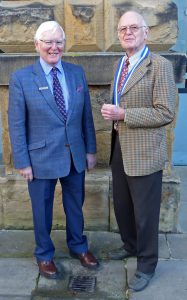
John Winkworth-Smith and Tony Byrne
5th November 2019
The general public may be surprised to hear of dyslexia being described as a ‘gift’, but this was the title chosen by today’s speaker, Club member David Leech. Being dyslexic himself, David could speak with authority and knowledge from his own personal experience.
Almost completely written off at school as being lazy, belligerent, disruptive, generally stupid and unteachable, it was not until very much later in life (at the age of fifty-two) that he was diagnosed as dyslexic. By now, however, he had developed a defence mechanism in the form of hypervigilance which enabled him to follow a career that demanded the sort of thinking and attention to detail which were his strengths. After a nine-year spell in the Royal Engineers, he joined the Police where, in his training, he was judged the top student in his group of sixty-eight fellow recruits. On retirement from the Police at the age of fifty he trained as a counsellor and graduated from Cambridge University with an honours degree in Creative and Expressive Arts in Counselling and Psychology – thus proving that people with dyslexia cannot be considered ‘disabled’ but, more accurately, ‘differently-abled’.
David went on to discuss the nature and classifications of dyslexia. It has a neurological basis which, in the main, can be caused by trauma (through illness or injury), hereditary influences, or during development of the foetus but, in all cases, the effects are that the brain processes information by a different method (visualisation) from that of a non-dyslexic. We are taught the shapes of letters and numbers, and we are taught that they mean something beyond that shape such that, when joined together to form words, sentences and formulae, they become an abstract representation. However, if the thing they represent cannot be visualised, then the dyslexic cannot decipher it. This does not alter the fact that a dyslexic person often comes with amazing strengths, including creativity, intuition, innovation, persistence, observation and many other benefits.
This was an inspiring and thought-provoking talk which generated a huge amount of discussion among the audience at its conclusion.

David Leech and Tony Byrne
15th October 2019
This was our Annual General Meeting, held in our regular venue at Chatsworth. At this AGM, the chairmanship was handed over from Ian Johnston to Tony Byrne, who then introduced the speaker, Club member John Hayes. Addressed to the members of a club which is proud of its reputation as being both welcoming and friendly, John’s talk, titled ‘On friendship and being generally friendly’ may have been thought somewhat unnecessary but, by analysing the concept of friendliness, it gave a deeper insight into the topic.
As the speaker pointed out, writers through history have commented on the need for friendship and the benefits that it can bring. From the time of the Classical Greek and Roman philosophers Aristotle and Cicero, through to more recent authors such as Rupert Brooke and even Michael Caine, the message has been that friendship creates happiness on a personal level and, for society in general, is an essential ingredient.
Turning his attention to the state of Britain today, the speaker quoted a number of statistics which demonstrate the need for us all to become more friendly to others, especially strangers. Loneliness is a big problem, with a reported 20% of the population claiming to feel lonely all or most of the time. Sixteen million of us live alone and, shockingly, 40% of hospital patients receive no visitors during their stay.
In summary, his message was, “Don’t be shy. Acknowledge the presence of others as you pass them in the street. Smile at the supermarket checkout person. You could be rewarded with some amazing fringe benefits from showing such friendliness.”
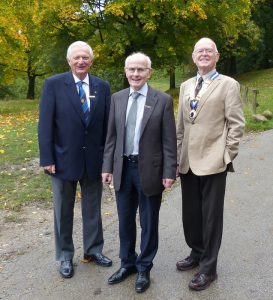
Ian Johnston, John Hayes and Tony Byrne
31st October 2019
Recognized by connoisseurs to be among the World’s finest wines, those of South Australia were the subject of this talk by Club member, Kim Rainsford. Growing up in Adelaide as a member of a long-established South Australian family, Kim had learned much about the history of the wine business and had visited many of the wineries, where he had got to know some of the descendants of the pioneering wine producers.
As he related, the development of the wine and spirit industry in Australia in many respects had its strong foundations in South Australia during the period following the establishment of the colony (later state) in 1836. The variety and type of soils and geology as well as the Mediterranean climatic conditions and the immense range of wine cultivars (varieties) served as a basis for the development of wine growing on what was to become a dramatic scale.
The industry grew from its early days thanks to the investment and foundation by the South Australian Company which established the colony, but it was the knowledge, skills, business acumen and enthusiasm of individuals that pioneers brought to the colony which enabled rapid establishment of the wine and spirit industry especially during the mid-late 19th and in the 20th centuries. Names of wines which are now familiar, such as Penfold, Seppelt and Hardy, have their origins in the surnames of these pioneers. Many of these people were from the UK, Germany and other parts of Europe. Among them were noted medical doctors (Penfold, Kelly, Allwark and Angove) who encouraged, and indeed in some cases, prescribed wines and brandies for patients.
An immense range of cultivars were imported from France, Germany, South Africa, Spain and Portugal, van Dieman’s Land (Tasmania), Victoria and New South Wales. Thus, there were the perfect ingredients for the establishment of what has become one of the most remarkable wine and spirit industries.
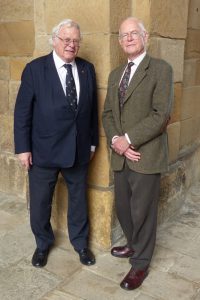
Kim Rainsford and Tony Byrne
17th September 2019
Guaranteed to give an entertaining and interesting talk, the speaker at this meeting was David Catton, one of our members. The title of his talk was ‘Characters Met in a Working Life’ but more revealing was the sub-title ‘The good, the bad and the downright evil’. He started by showing a list of the jobs in which he had been employed, ranging from a laundry worker in Liverpool as a 17 year-old student in 1961, through periods of employment as a product planner and financial analyst in the motor industry, eventually running his own technology businesses by the time of his retirement.
Looking at these occupations in turn, he then described some of the people with whom he had come into contact and, as his talk progressed, it demonstrated how the style of management in business and attitudes to gender equality have changed over the past half-century. In the 1960s and 1970s many of the senior managers in industry had served in the armed forces during the War and therefore carried forward into their civilian lives the military methods of personnel management to which they had become accustomed in their military careers. Many of them, whilst probably well suited to managing unquestioning subordinates in the forces, were clearly incompetent when it came to managing a civilian workforce. Over time, the style of business management became far more conciliatory and, consequently, more effective.
In his time, the speaker had met and worked with many notable people including, when an undergraduate at King’s College London, the cosmologist and mathematician, Professor Hermann Bondi. Later, when working at British Leyland, David knew the designer of the Mini, Sir Alec Issigonis, as well as many other colleagues in that Company. Relating stories – some of them unsuitable for publication, alas – about these and other characters whom he had known throughout his working life, the speaker kept his audience, including two guests from the Buxton Probus club, entertained for an hour.
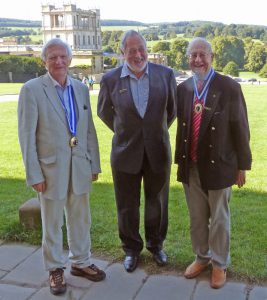
Ian Johnston, David Catton and Roy Pickles (President, Buxton Probus)
3rd September 2019
A television series broadcast by the BBC in 2002 was conducted to determine who the British people considered to be the greatest Britons in history. Unsurprisingly, top of the poll was Sir Winston Churchill, but the viewers’ second choice was the 19th century engineer and entrepreneur, Isambard Kingdom Brunel. He it was who was the subject of this talk by club member, Brian Barry.
The speaker had clearly carried out much research into the life and achievements of his subject. As he related, Brunel was born in 1806, the son of a French father (Marc Isambard Brunel) and English mother (Sophia Kingdom). He showed early promise in his education to the extent that, at the age of 14, he was admitted to the University of Caen in France, and subsequently at the Lycee Henri IV in Paris. Returning to England, he worked for several years as an assistant to his father on building the world’s first underwater tunnel below the Thames between Rotherhithe and Wapping. This was a difficult and hazardous project which, in the event, took 18 years to complete.
During this time, Brunel turned his attention to designing and building the projects for which he would justly become famous. Chief among these were the Clifton Suspension Bridge (near Bristol), the Royal Albert Bridge (at Saltash), and the Great Western Railway (linking London with Bristol). With the aim of extending the reach of the GWR from Bristol across to North America, Brunel designed steam-powered ships – the SS Great Western and SS Great Britain – capable of the trans-Atlantic crossing without the use of sails.
Alas, as the speaker explained, Brunel was also responsible for a number of expensive and ultimately unsuccessful projects. A railway in South Devon was built by him, based on the principle of using a vacuum system to drive the trains. This never worked satisfactorily and had to be replaced by a conventional railway. Finally, Brunel over-reached himself by building a huge coal-fired ship, SS Great Eastern, which was intended to be capable of sailing to Australia without refuelling en route. The difficulty of building and launching such a leviathan, and an on-board explosion during the vessel’s maiden voyage took their toll on Brunel’s health and he died, through over-work and stress at the age of 53.

Ian Johnston and Brian Barry
20th August 2019
With a general election possible later this year, this talk may prove to have been extremely relevant. For this special meeting, Speaker Coordinator, Peter Holt, had arranged a guest speaker, Dr. Kate Dommett, from Sheffield University. Her talk examined the role of digital technology in elections and it considered the likely effects of this technology on the outcome of elections.
The speaker pointed out that the use of this technology started at the end of the last century but, at that stage, its reach was limited because what was to become known as social media had yet to be developed. Since then, however, political parties have found sophisticated ways to spread their message with the object of motivating the public (and, in particular, their own supporters) to become more involved in the political process. At the same time, social media has opened the way for various pressure groups to flourish – some of them with extreme agendas and peddlers of ‘false news’.
With almost 80% of internet users in the UK having a profile or account on a social media or messaging site, this gives political parties the ability to analyse and make use of personal data and interests which the public freely, but often unwittingly, post on these sites. However, in spite of the political parties’ ability to access and make use of such data in targeting their campaigns, there is still little way of knowing how effective this is.
Dr. Dommett expressed concerns about the dominance and secrecy of technology companies, such as Facebook, and pointed out the lack of transparency about what these companies are doing and how they are funded. It is becoming clear that some form of regulation is needed but discussion revolves around the question of who should be responsible for this – the social media companies, Government, or the users themselves?
Unsurprisingly, in view of the topicality of the subject, there was a lengthy question and answer session between the audience and the speaker at the conclusion of her talk.
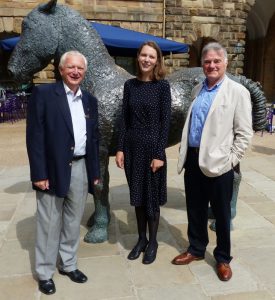
Ian Johnston, Kate Dommett and Peter Holt
6th August 2019
Although not as well known in the Bakewell area as they once were, the Barker family has had a significant impact on the economic and social development of the town and its neighbouring villages. Today, the story of this family was related by guest speaker Peter Barker (no relation), assisted by his wife, Marian.
The speaker described how the Barkers were first recorded to have arrived in the area in the mid-sixteenth century and thereafter flourished as influential gentry in the employment of the Dukes of Rutland and Devonshire. They were also involved in the developing lead industry during the eighteenth century and later accumulated real estate assets at the time when Bakewell’s agricultural land was being enclosed. One member of the family, William, established himself as a member of the Levant Company whose purpose was to promote trade with the Eastern Mediterranean and North Africa.
The family is associated with several of the more notable buildings in the local area. Rowsley Hall (now the Peacock Hotel) was built by Henry Barker in 1652, and Bagshaw Hall in Bakewell was owned by Thomas Barker. Two other Bakewell properties, Burre House on Holme Lane and East Lodge (now Brooklands) on Coombs Road were owned by members of the family, as was Ashford Hall.
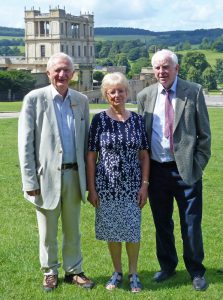
Ian Johnston, Marian Barker and Peter Barker
2nd and 16th July 2019
Club member Peter Stubbs’ talk on the war at sea between Britain and Germany during World War I, was presented at two consecutive meetings. At the first, he described how the Naval Defence Act of 1889 required the British navy to be increased in strength such that it became at least as powerful as the world’s next two largest navies combined. This was to safeguard the trading routes between Britain and its Empire upon which it relied for providing the vast amounts of raw materials needed for food and industry. At the time, the greatest threat was seen to come from France and Russia, rather than the German states, many of which had previously been allies of Britain. However, all this was to change when the German Emperor, Kaiser Wilhelm II, embarked on a course aimed at making Germany into a major world power by rapidly expanding his own navy.
The British response to this escalation of Germany’s naval capabilities was to modernise the Royal Navy. This included the introduction of the Dreadnought class of battleships together with their escort destroyers and submarines. Hence, as the speaker explained, although Germany at the outbreak of hostilities in 1914 was the pre-eminent European power on land, Britain still retained its dominance at sea. Throughout that year, there were several skirmishes between the British and German fleets, many of them inconclusive, until on the 7th December, a major battle was fought in the waters around the Falkland Islands. On this occasion, the Royal Navy was clearly victorious which resulted in Britain re-establishing her control over the seas around the world except for the North Sea and the Western Approaches.
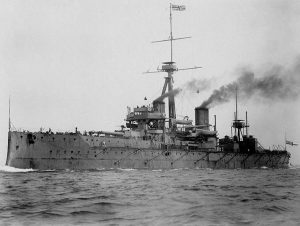
HMS Dreadnought
In his second talk, Peter described how vulnerable Britain still remained closer to home. On 16th December 1914, the Germans launched an attack by shelling from warships on Scarborough, Whitby and Hartlepool. These were predominantly civilian targets and the resulting outrage at this unprovoked action served to boost recruitment to the British war effort and to sway previously neutral countries towards the British cause.
The conventional war at sea continued until the Battle of Jutland in 1916. Both sides suffered heavy losses but thereafter the German High Seas Fleet remained in port for the rest of the war. In effect, the surface war was ended. However, the German navy deployed submarines which, by attacking merchant shipping, threatened Britain’s essential supplies of imports. One such attack, in this case on a passenger liner, RMS Lusitania, eventually led to the United States declaring war on Germany. The enormous losses caused by submarines were becoming unsustainable but, finally, the situation was resolved by Britain employing the convoy system whereby groups of merchant ships were escorted throughout their voyage by warships.
At the end of the war in 1918, the German fleet was interned at Scapa Flow where the ships were manned with skeleton crews of German sailors under British guard. It was in the following year, while negotiations over their disposal were in progress among the victorious allies, that the ships were scuttled by the German crews themselves.
This was a fascinating and absorbing story which demonstrated the enormous amount of research which Peter had carried out into his subject.

Ian Johnston and Peter Stubbs
18th June 2019
Much of the latter half of the 20th century was a period of tension between the Soviet Union with its satellite states of Eastern Europe, and the United States with its Western European allies including Britain. This was known as the Cold War and it was the subject of this talk by member, Malcolm Young, who had been a reconnaissance pilot in the RAF at the time and had commanded a reconnaissance squadron.
He described how nuclear weapons had been developed by both the Western and the Eastern powers and it was recognized that the fear of mutually assured destruction (MAD for short) would act as deterrence against nuclear powers from attacking each other with these weapons. Strategic nuclear deterrence from the 1950s to 1969 was the responsibility of the RAF but, since then, it has been the responsibility of the Royal Navy, with Polaris and now Trident armed submarines.
The theory of deterrence assumed that before any war reached the nuclear stage there would be a build-up of tension, and then probably a graduated escalation with non-nuclear weapons, such as a tank attack by the USSR across the German plain. In order to deter a higher level of conflict, which would be an all-out nuclear attack on the West, the UK ensured that it would have the capability to deploy over 100 aircraft armed with very powerful strategic nuclear weapons. At times of high tension there would always be some planes in the air. (Just as now in principle there is always a Trident submarine ready to attack.) Hence the Soviets could never be sure that they would destroy all our planes or submarines, in which case, even if only one of them survived, it alone had the destructive power to deter any such Soviet aggression.
As the speaker explained, the RAF bomber aircraft had two broad target areas – The Kola Peninsula in the north of the USSR and the Baltic states (then behind the iron curtain). In the event of an alert, the planes would take-off and head for Norway as far as the 8th meridian east of Greenwich. If they passed that point, there would be no calling them back, and all-out nuclear war would be inevitable. In such circumstances, Malcolm’s job would have been post-strike reconnaissance to see what effect the bombs had had. He described several worrying incidents when the Soviets believed themselves to be under attack but, fortunately for all humanity, these were recognised as false-alarms and no action was taken in response.
In conclusion, Malcolm thought that the deterrence theory had worked, since no atomic or nuclear bombs have been used in anger since the two dropped over Hiroshima and Nagasaki at the end of World War II, but he was worried about terrorists and rogue states who might think they had nothing to fear from reprisals.
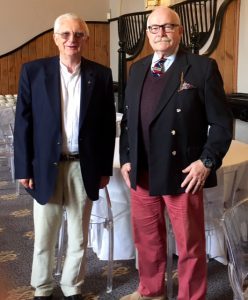
Ian Johnston and Malcolm Young
4th June 2019
The Peakland parish of Youlgrave is an unlikely place to be associated with international espionage but it was here that, in 1915, the future chief of Britain’s Secret Intelligence Service (MI6), Sir Maurice Oldfield was born. At this meeting the story of this man’s life and achievements was told by his nephew, Martin Pearce, who was introduced by club member, Ainslie Kelly.
His family being unable to afford the fees, Maurice was fortunate, at the age of fourteen, to win one of the free places at Lady Manners School where, with his formidable memory and capacity for hard work he excelled in most subjects. After school, he studied for a degree in mediaeval history at Manchester University, subsequently joining the Army in the Intelligence Corps. A series of postings around the world provided him with the experience and seniority to be promoted to the position of Director of MI6 in 1973, a role which he filled until his retirement in 1978.
In his later years, Sir Maurice became the subject of a number of accusations of inappropriate behaviour, none of which were ever substantiated but which had the effect of damaging his reputation. It was therefore with the intention of telling the true story of his uncle’s life that the speaker started his researches, not only into the official records (which proved extremely difficult to access) but also by talking to the people who had known him. These included politicians, authors and, because Sir Maurice had always retained his Derbyshire roots, his local friends. Martin Pearce’s resulting book was first published in 2016 and is an absorbing read.
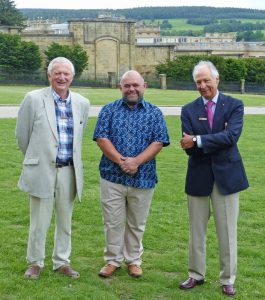
Ian Johnston, Martin Pearce and Ainslie Kelly
21st May 2019
At this meeting we were intrigued to hear local entrepreneur, business owner and member of the club, Chris Shepley, talk unashamedly about his experience of unemployment. Leaving school with a single ‘A’ level, he tried to get into quarry management at the age of eighteen. However, a variety of quarry mishaps and closures led to him having to find six jobs in quick succession. It was therefore no surprise that, after the sixth job ended in 1966, he decided to abandon the dangerous, dirty and outdoor quarrying industry for the more agreeable conditions of indoor employment. This was in a plastic moulding business called W. E. Amies of Chesterfield which was part-owned by his father.
In his late-twenties, Chris chose to rectify his lack of formal vocational education by undertaking a Diploma in Management Studies which he found to be very helpful and he was able to put into practice a lot of what he had learned.
When his father died, Chris bought out the other shareholders in W. E. Amies, and became owner manager. He is clearly very proud of the company and its staff. The business was founded in 1929 and has consistently offered employment to 30-35 people. Chris believes it is the oldest plastic injection moulder in the UK still operating under the same name.
As Chris explained, the basic process of injection moulding is to inject plastic powder into tool moulds designed and supplied by external manufacturers for key plastic components. Showing examples of their products, he said that one of the main reasons that Amies has survived for so long in competitive markets is that they always work for several customers and do not let any one customer dominate their order book. Two other rules he applied were to “keep it simple and to avoid debt”.
His final point was to reflect that experience, both for him and his staff, has been an invaluable guide, so his message to any young person who does not immediately succeed at school or in the job market is “Don’t give up; go get some experience wherever you can”.
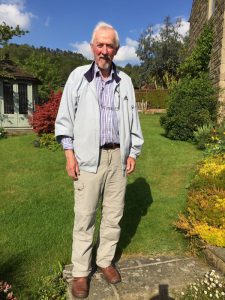
Chris Shepley
30th April 2019
The dictionary defines a philanthropist as a person who seeks to promote the welfare of others, especially by the generous donation of money to good causes. Throughout history there have been many such people but the 19th century seems to have produced an exceptional number of them. Names like Joseph Rowntree, William Booth, or Thomas Barnardo spring readily to mind, but possibly less well known is Charles Wicksteed who was the subject of this talk by his great grandson, club member Jonathan Wicksteed.
In researching the life of his great grandfather, the speaker had found evidence of a man brought up in a non-conformist, religious family amongst siblings who were all talented in various ways. Charles himself was an engineer, inventor and author whose writings included books in which he displayed his social conscience and concern for the working classes. In spite of early setbacks in his life, he managed to overcome these and, through his eventually successful engineering business, became a wealthy man. Thus, he was able to afford to put into practice his humanitarian ideals and he did so by purchasing land in Kettering on which he established a park, complete with a pavilion for social functions, boating lakes and a children’s playground, all of which was provided free of charge to the public.
Although it has seen changes and developments in the century since it was founded, Wicksteed Park still bears his name and remains a popular visitor attraction. No doubt Charles would have been proud to know that his creation has remained true to his philosophy and that the park’s children’s playground is now the largest free facility of its kind in Europe.

Ian Johnston and Jonathan Wicksteed
16th April 2019
It is now recognised that flying is the safest form of travel, and statistics show that it is getting even safer. From a total of almost 2,400 airliner accident fatalities worldwide in 1972, this figure had dropped to 60 by 2017. As described in this talk by Club member, Brian Holland, much of this improvement came about as a result of work done in the industry to counter the effects of one of the remaining hazards to flying (particularly when planes are taking-off or on approach and landing), bird-strikes.
In a meticulously researched talk, Brian gave examples of some of the catastrophic accidents that have been caused by aircraft flying through flocks of birds or even by a single large bird such as a goose. If drawn into a jet engine, birds can damage the fan blades or, if ingested into the core of the engine, cause it to lose power, often at the most critical stage of the flight. As a result of such accidents, the civil aviation authorities developed a number of regulations which required aircraft manufacturers to design engines that were ever more resilient to the effects of bird strikes.
The speaker also outlined a series of measures that can be taken to mitigate the risks posed by birds at airports. These include deterrents such as the removal of food sources, water and cover, dispersal techniques, and detection by avian radar.
As though to illustrate the effectiveness of the measures taken by the industry to reduce the danger of bird strikes, two members of the audience reported that, in separate events, each had experienced (and, of course, survived) an incident of a plane striking birds.
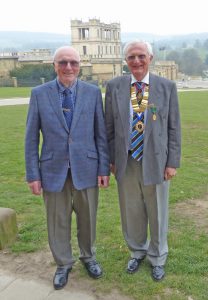
Brian Holland and Ian Johnston
2nd April 2019
Sorting through the paperwork and personal possessions of a recently deceased parent is a sorrowful task but it can reveal long-forgotten documents which, by virtue of their age and relevance to the contemporary events which they describe, prove to be of great interest. Such was the case when the speaker at this meeting, member Neil Spaven, discovered a copy of The Daily Mail Golden Peace Edition, dated June 30th 1919. This led him to carry out more research into World War I and, in particular, the role played by the Press during that conflict.
Soon after the start of the war in 1914, the Defence of the Realm Act was passed by Parliament. This, in conjunction with the existing Official Secrets Act, imposed censorship on journalism and letters coming home from the front line, with the effect that only the more positive news reached the public and reports of Allied military losses were supressed. Illustrating his talk with pictures of some of the posters from the period, Neil showed how these were designed to encourage recruitment to the armed forces and to glorify the Allies’ cause.
He then described how the Directorate of Special Intelligence (MI7) was formed in 1915 to ensure that the military authorities maintained control over the Press, thus creating a powerful and effective propaganda machine. However, the use of these tactics was later to have disastrous unintended consequences because, in the 1930s, reports of the persecution of Jews in Europe was claimed by the Nazis to be yet another example of Allied anti-German propaganda and therefore ‘fake news’.

Ian Johnston and Neil Spaven
19th March 2019
Now an annual event in March, we chose for the debate this year the proposition that ‘This Club believes that private education should be abolished’. Leading the discussions were Jeff Marsh who supported the proposition and Peter Stubbs who opposed it, with Ian Johnston overseeing the proceedings.
In his arguments favouring the abolition of private schools, Jeff Marsh acknowledged that, in general, these institutions provide an excellent standard of education delivered by well qualified teachers in small class sizes. However, he believes that these factors create an ‘elite’ stratum of society which accounts for a vastly disproportionate percentage of privately educated people in positions of power and influence. Furthermore, private education is seen to be fundamentally unfair because it allows the wealthy to buy for their children benefits that are denied to those educated through the state system. Jeff also made the point that many private schools have charitable status which relieves them of some tax liabilities. Hence, in effect, they are being subsidised by the tax-payer – an additional example of the unfairness in the system.
Responding to his opponent, Peter Stubbs defended the status quo by arguing that, in a free society, people must be allowed to spend their money in whatever lawful ways they choose. For example, he pointed out that many people relocate for the sole purpose of moving to a better schools catchment area, thus buying for their offspring similar educational advantages to those offered in the private sector. He also said that abolition of the private schools would have the effect of overburdening the state schools with the children displaced from the former.
Following these opening submissions, the debate was continued with numerous contributions from the floor, many of them condemning, in particular, the unfairness of conferring charitable status on the private sector. At the end of the debate a vote held among the audience resulted in a significant majority against abolition of private education but, in supplementary votes, there were similarly large majorities in favour of abolishing charitable status for these institutions and in favour of improving the funding of state education.
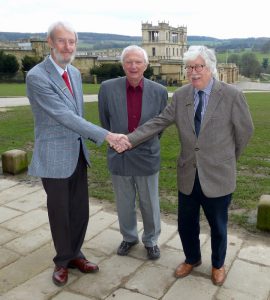
Jeff Marsh, Ian Johnston and Peter Stubbs
5th March 2019
At present, a relatively small percentage of people in the developed world are vegetarian but the remainder of the population is going to have to reduce, or eliminate, its consumption of meat over the course of the next few decades. This was the stark message delivered by club member, Roger Taylor, at this meeting. The speaker, who was born of farming stock and, in his varied career, a well-known local restaurateur, naturally has an interest in food production and catering.
As he pointed out, in a world whose human population is set to approach ten billion by 2050, it will not be possible to devote the level of resources necessary to satisfy the demand for meat if it continues to rise at its current rate. To illustrate the problem, he quoted some statistics – at present 30-40% of the world’s usable land area is given over to livestock rearing, 15% of greenhouse gasses are produced by livestock and, remarkably, 15,000 litres of water are needed to produce 1 kilogram of meat. This is an extremely inefficient and unsustainable way of producing food when these resources of land and water could be better and more efficiently used for growing vegetable crops to feed the growing population.
In order to gratify the existing and future demand for meat products, such as burgers, a new approach needs to be taken which Roger then discussed. By creating meat substitutes from plant material treated with animal stem cells, these foods can be made to replicate the taste and texture of meat but with far more efficient use of agricultural land and a much reduced effect on the environment. Through the use of this bio-engineering technology, there are now several large businesses involved in producing this ‘artificial’ food. It seems that, in this respect, the future has already arrived.
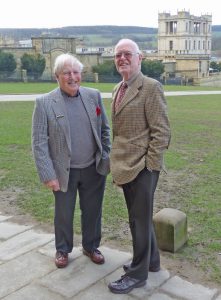
Roger Taylor and Tony Byrne
19th February 2019
“We live in turbulent times – and never has effective political leadership been so important.” This was the theme of club member, Peter Holt’s presentation today. He developed his talk, using examples, by analysing and assessing the performance of recent political leaders – especially in western democracies.
Closer to home, Peter examined the importance of the context in which political leaders operate and the personal attributes necessary for a successful Prime Minister. These included characteristics such as courage, luck, hunger for power, the energy and stamina for hard work, and the willingness to perform a U-turn when necessary. This may be thought a bizarre combination of qualities but the electorate expects its leaders to be able to possess them all. In truth, of course, it is an impossible task but, nevertheless, we frequently blame them when they fail. To illustrate his arguments, the speaker considered the achievements and failings of Margaret Thatcher and Tony Blair, both of whom made significant contributions to the social development of the nation but whose legacies were tarnished by the Poll Tax and the Iraq conflict, respectively.
He considered the populist movements which are gaining momentum across the globe and emphasised just how political leaders exploit the people who are often “forgotten”. In particular, the policies of Donald Trump were analysed. The speaker pointed out that although the leaders of populist movements claim to represent dispossessed people, their actions carry their own dangers and often lead to turbulence.
This was an absorbing, thought-provoking and, in these times of political uncertainty, exceedingly relevant talk.
5th February 2019
Although there are some rival claims to the title, the North East of England is generally accepted as the true birthplace of the railways and it was from this background that one of the most geographically extensive companies, the North Eastern Railway (NER) developed in the 19th century. At this meeting our guest speaker was Phil Crosby whose great grandfather had joined the NER in 1858. He was followed by his son in 1885 and, in turn, his grandson, the speaker’s father, in 1923. Making a fourth generation to work on the railways, the speaker started his career at the Darlington railway works where he embarked on an engineering training scheme which combined college study with practical experience in many operational aspects of the railways.
On completing his training, the speaker’s first job was as a shift foreman in charge of almost 60 staff at Gateshead locomotive depot. As he related, this was very much a baptism of fire – he, in his early twenties found himself in charge of a group of men, some of whom were over twice his age and with vastly more experience. However, he learned quickly and, in a series of promotions to postings around the Eastern Region of British Rail, he eventually reached a senior position within the industry.
During the course of his career he was required to deal with a number of incidents on the railway, and he described two accidents. The first was at Morpeth in 1984 where, travelling at 93mph (which was more than three times the speed limit), a sleeping car train left the rails on a severe curve. In another incident, a train was derailed by faulty track work. In neither of these accidents were there any serious injuries to those on board; a testament to the strength and crash-worthiness of railway passenger vehicles.
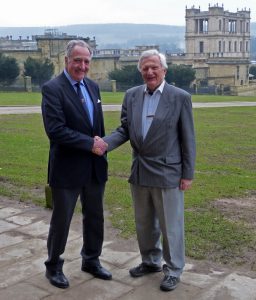
Phil Crosby and Ian Johnston
15th January 2019
Although victorious after six years of war, Britain in 1945 was a bruised and impoverished country whose people had suffered much hardship throughout the conflict. With the idea of providing ‘a tonic to the nation’, the post-war Labour government decided to hold a Festival of Britain in 1951, inspired by the Great Exhibition of a century earlier. The story of how this event came about and his own experience of visiting it, was told to us by Club member Don Naybour at this, our first meeting of 2019.
As Don related, the first idea for an exhibition was suggested by the Royal Society of Arts in 1943 and it was envisaged as a showcase for British engineering, technology and design. With large swathes of Britain’s cities in ruins, the aim of the festival was to show the way that modern methods and materials could be used in the process of reconstruction. For this reason, its administrative team included some of the leading experts of the day in their respective fields of architecture, engineering and the arts.
The festival was a national event, with displays at numerous sites around the country, but the main focus was on the South Bank of the Thames where a number of modernist buildings and structures were constructed for the five months of the exhibition. A second site in London was in Battersea Park where the Festival Pleasure Gardens were set up. More than simply a fairground, this included restaurants and shops as well as the gardens themselves.
Opened to the public in May 1951, the festival proved immensely popular with more than eight million visitors to each of the main sites in London. Included in these was Don himself who could therefore speak from personal knowledge, as could several of the members of his audience who, at the end of the talk, were able to add their own reminiscences of the event.

Ian Johnston and Don Naybour

© Bakewell and District Probus Club, 2014-2024